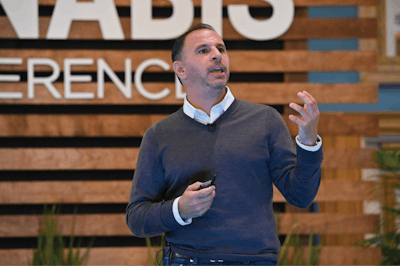

“The challenges in the cannabis industry are numerous, but they are not insurmountable.”
That was the message Cannabis Conference Programming Director Cassie Tomaselli delivered to attendees during her welcome address at the three-day event hosted at Paris Las Vegas Hotel & Casino in August.
The leading educational event for plant-touching businesses drew some 2,500 attendees nearly all 50 states and 30 countries to connect and learn, have honest conversations about business pain points, and share potential solutions to persistent problems that cannabis cultivators and retailers face each day.
More than 100 speakers provided expertise on topics ranging from the latest in cultivation research, facility design, and selecting the best genetics to marketing and budgeting tips, how to leverage customer and sales data, and how to optimize the extraction process.
New challenges, like historic inflation, compounding the already perennial problems of the 280E tax burden and federal illegality of cannabis were noted frequently throughout the event. Many recognized that this made it an even more important time to gather and discuss paths for moving forward.
In a post-event survey, Cannabis Conference attendees commended the value of both the educational program and the more than 180 exhibitors with solutions curated specifically to plant-touching businesses.
“By far the best show of the year,” one attendee wrote.
“The conference was exceptionally educational, and it provided ample opportunities for networking,” shared another.
Although it’s impossible to fully encapsulate, the 2022 event delivered numerous lessons and quotable moments. Here, Cannabis Business Times editors share some key takeaways.

“We need advocacy so that the industry can reach its full potential.” — Noelle Skodzinski, Editorial Director, Cannabis Business Times and Cannabis Conference

1. “Constantly remove the friction from your day.”
Unexpected and difficult challenges abound in the cannabis industry. During his keynote address, Mitchell Baruchowitz, founder and managing partner of Merida Capital Holdings (pictured, above), acknowledged this cycle of constant problem-solving. There are constructive ways of dealing with daily hurdles without draining creative and innovative energy, strategies that have helped the team at Merida, he noted.
There are two futures in the cannabis industry—the one that will “arrive” naturally through consumer and market demands for products, and the other that will be built and determined by companies on the cutting edge who are innovating and growing despite cannabis’ federally illegal status, tax burdens, competition from the illicit market and other perennial challenges. Companies need to be ready to take action and be a part of the future that will be built, he said.
He encouraged the packed house to think about problems or conflicts that arise on a daily or weekly basis, ask two questions, and imagine how they can resolve consistent headaches.
“One, can you change it ... can you remove it?” he said. “If you have to deal with it, how can you shape and orient that problem so that it doesn’t suck your energy out every day?
“Succeeding in the cannabis industry really is about removing these small splinters … it’s about identifying in yourself what’s holding you back” and to “constantly remove friction from [your] day,” he said.
Doing this can help company leaders focus on the long-term goals and strategies that are going to matter most and be part of the “future that will be built,” and better deal with the small hurdles that try to throw them off course.
“When facing a problem or addressing a challenge, realize you’re building something,” he said.
“Has anyone in here had an exit on the table, and they kind of missed their window, and now we’re in a capital crunch and everything’s kind of gone down in value, and you want to beat yourself up over it?” he asked. “But don’t. No one knows the cycles of this. The reality is, if you have the right open mind and approach, it’ll be there for you again. This is going to go back up. There will be wind in our sails, and it’s not always going to be a headwind.”

2. Keep customers top of mind.
During the session “How to Launch a Medical or Adult-Use Dispensary,” panelists noted the importance of hiring and customer service to the success of retail operations.
“Customers notice turnover. People that utilize cannabis tend to be more sensitive,” said session moderator Anna Shreeve (pictured above, right), president of The Bakeréé, a dispensary based in Seattle. “They want to have that relationship.”
Establishing trust with customers is also an essential component of that relationship building. Shreeve asked if attendees include taxes in their pricing and urged those who are not to consider doing so. Otherwise, “consumers think it’s false advertising. … It’s like a bait and switch.”
Keeping close tabs on inventory is crucial, and it’s important to monitor this regularly, noted Tucky Blunt (left), CEO and owner of Blunts + Moore dispensary based in Oakland, Calif. “Stay on top of inventory and what’s selling. Every night I check myself what’s been sold,” Blunt said.
Consumer insights can be found both in data and in conversations in the dispensary, said David Melnick (center), co-founder of Feel State, a franchise dispensary brand with locations in St. Louis and Kansas City, Mo. “Stand on the floor for two or three hours and listen to customers and budtenders talk,” Melnick said.

3. “Use data more as a gut check than a North Star.”
While data is an essential tool for businesses to make decisions, from product assortment to staffing, each of the panelists on the session “Using Data to Boost Sales & Improve Inventory Management” cautioned that there can be fallacies in the numbers. “Use data more as a gut check than a North Star,” said Jesse Channon (pictured above, third from left), chief growth officer at Columbia Care. The metrics that matter most to your business may differ from the dispensary down the street as well.


4. Consider intangible metrics such as the team, brand and IP when determining your company’s value.
Determining a company’s value isn’t only important when businesses are looking to merge or sell. During the session “What’s Your Company Worth? How to Build a Business Valuation,” panelists noted the various benefits of determining your plant-touching cannabis company’s worth and why it’s important to consider the intangibles or aspects of your company that aren’t easily appraised.
Companies need valuations for raising capital, reporting finances and compliance reasons, as well as during M&A transactions. Each is impacted by the constraints of 280E, cannabis’ federally illegal status and the fact businesses are confined to a limited marketplace, noted panelist Hubert Klein (pictured above, right), partner at EisnerAmper LLP.
Commoditization is another hindrance to industry growth, said Claudio Miranda (left), co-founder of Guild Enterprises, who moderated the panel. Licenses, revenue and intellectual property can all protect against commoditization, Miranda noted, but, he added, “It’s expensive to defend patents and enforce them in the marketplace.” Branding is another way companies can stand out.
“As this industry goes into further commoditization, you need to think about the strength and power of that brand,” he said. “In valuations with M&A, you have to think about who is your prospect. Valuations aren’t a standard one-size-fits-all.”
“People are looking for consistency. Brand is really important. It will all migrate toward brand at some point because [people want] consistency,” added Douglas Hannah (middle), partner at Silverleaf Venture Partners.
One of the most important assets of any company is the management team, Klein said. Hannah echoed his sentiment.
“We put a lot of credence into the team; the team is critical to the execution,” Hannah said, adding that he’s seen teams of superstars not work well together, and it’s not just about the people, but the collaboration.



“We’re coming to a point where university research has really helped the cannabis industry.” — Dr. Bruce Bugbee, Professor, Utah State University
5. University research is vital—and private funding is bringing it into the mainstream.
Utah State University Professor Dr. Bruce Bugbee expounded on the importance of licensed businesses partnering with universities to fund and produce cutting-edge scientific research on the cannabis plant. During the “University Research Roundup” panel, Bugbee told the audience, “We’re coming to a point where university research has really helped the cannabis industry,” noting the decades of underground research that preceded this newly “open” environment. Still, only a trickle of federal research grant dollars has made its way to those studying cannabis.
One such federally funded project was discussed on that same panel: Dr. Michael Gutensohn, a West Virginia University associate professor, discussed his USDA-funded research into the terpene-cannabinoid metabolic network—and how, precisely, THC develops when the cannabis plant encounters biotic and abiotic stressors. This is critical to understanding why hemp “goes hot” in the field, but also to grasping the fundamental chemical building blocks of this plant.

“There is no such thing as a good deal with a bad business partner.” — Obie Strickler, CEO, Grown Rogue

6. Learn the language of finance.
LeVon Terry of Capfluent and Patrick Rea of Poseidon Investment Management discussed the conversations that entrepreneurs are encouraged to have when pitching their business as a potential investment opportunity. It’s vital, Terry said, to speak frankly and clearly with investors. “It can be intimidating … to learn the language of finance in order to have these conversations, but it is important,” he said. “We appreciate entrepreneurs asking questions. Don’t be afraid to push on capital.” The conversation was moderated onstage by Colin Kelley of Merida Capital Holdings, who pointed out that due diligence is critical before and during the pitch meeting.
In a separate session, Grown Rogue CEO Obie Strickler agreed on the importance of choosing your business partners wisely. “There’s no such thing as a good deal with a bad partner,” Strickler said.


“The regulations just don’t permit us to do our jobs [and educate the market]. “ -Paul Weaver, Director, Head of Cannabis, Boston Beer Co.
7. Location, location, location.
Your region and weather patterns will affect how you cultivate in a number of ways—namely if you do so outdoors, indoors, or in a greenhouse. However, growing in a greenhouse combines the best of both environments, as unanimously agreed by the quartet of panelists. During the session “Facility Design – Greenhouse,” speakers noted if you’re fortunate enough to choose where to build your greenhouse, as opposed to acquiring an existing facility, then consider not only a number of regional and environmental factors, but also how close your facility is to ancillary businesses and how that may impact your production timeline. Salpy Boyajian of Las Vegas-based Flower One said if a gear breaks in your greenhouse, it’s better to be able to drive down the road to buy another than have to wait on shipping from a vendor in another state. Bottom line: When it comes to greenhouses, it is critical to understand the local environment in order for your cultivation operation to succeed.



“We focus on engaging budtenders and incentivizing them to get the products out.” — Jonathan Spadafora, (right of center), president, Veritas Fine Cannabis
8. Consider the community when developing a brand.
During the session “How To Become A National Cannabis Business,” Kate Miller, co-founder and CEO of Miss Grass, urged the audience to consider the community that their brand is attracting before launching new products. In this way, a brand can generate a real sense of self, and that is necessary for any national business expansion aspirations. Too many brands, she pointed out, tend to put the cart before the horse and begin shipping product into the market before knowing precisely what sort of values their company represents. Scaling a business to a multistate level can be very difficult, but you’re only making it harder on yourself by avoiding this crucial community-building phase.

















